Gamification, the application of game-design elements and principles in non-game contexts, has been gaining popularity in various industries. In recent years, companies have started incorporating gamification into their employee platforms to enhance engagement, motivation, and productivity. You can visit https://spinify.com/ to gain popularity in various industries of gamining. By leveraging game mechanics such as competition, rewards, and progress tracking, businesses are transforming the way their employees interact with tasks and processes.

The Rise of Employee Platforms
Employee platforms are digital tools or systems that companies use to streamline communication, collaboration, and workflow management among their employees. These platforms serve as central hubs for information sharing, project tracking, and performance evaluation. By integrating gamification into these platforms, organizations are able to create a more dynamic and engaging work environment.
Benefits of Gamification in Employee Platforms
- Enhanced Employee Engagement: Gamification makes tasks more interactive and enjoyable, leading to higher levels of engagement among employees.
- Increased Productivity: By introducing elements like challenges, leaderboards, and rewards, gamification can motivate employees to be more productive and efficient.
- Improved Learning and Development: Gamified platforms can facilitate continuous learning and skill development through interactive training modules and quizzes.
- Boosted Collaboration: Gamification encourages teamwork and collaboration by fostering a sense of competition and achievement among employees.
- Better Performance Tracking: By tracking employee progress and performance in real-time, gamified platforms provide valuable insights for continuous improvement.
Key Features of Gamified Employee Platforms
Successful gamification strategies in employee platforms often incorporate the following key features:
Reward Systems
- Points: Employees earn points for completing tasks, achieving milestones, or demonstrating specific behaviors.
- Badges: Virtual badges are awarded to recognize accomplishments and encourage continued engagement.
- Levels: Progressing through different levels signifies mastery and unlocks new challenges or rewards.
- Prizes: Incentives such as gift cards, extra time off, or special privileges motivate employees to actively participate.
Competition and Collaboration
- Leaderboards: Public rankings showcase top performers and stimulate healthy competition among employees.
- Team Challenges: Collaborative tasks and challenges promote teamwork and foster a sense of community within the organization.
Progress Tracking and Feedback
- Performance Metrics: Employees can track their progress and performance metrics in real-time to gauge their success.
- Feedback Mechanisms: Instant feedback and performance evaluations help employees identify areas for improvement and celebrate achievements.
Case Studies: Companies Embracing Gamified Employee Platforms
1. Salesforce
Salesforce, a leading cloud-based software company, utilizes a gamified platform called Trailhead to train and upskill its employees. Through interactive modules, quizzes, and challenges, employees earn points and badges as they progress in their learning journey. This approach has significantly increased employee engagement and knowledge retention within the organization.
2. Microsoft
Microsoft introduced a gamified platform called Microsoft Rewards to motivate employees to adopt healthy habits and practices. By earning points for activities like staying active, getting enough sleep, or practicing mindfulness, employees can redeem rewards and compete with colleagues. This initiative has not only improved employee well-being but also fostered a sense of camaraderie and support among coworkers.
Challenges and Considerations
While gamification in employee platforms offers numerous benefits, companies may encounter some challenges in implementing and maintaining these systems:
Resistance to Change
- Some employees may be hesitant to embrace gamified platforms due to unfamiliarity or skepticism about the effectiveness of gamification in a corporate setting.
Overemphasis on Rewards
- Excessive focus on rewards and incentives may lead to a superficial engagement with the platform, undermining intrinsic motivation and long-term behavioral change.
Monitoring and Data Privacy
- Collecting and analyzing employee data for gamification purposes raises concerns about data privacy, security, and ethical use of personal information.
Conclusion
Overall, gamification in employee platforms represents a promising approach to enhancing employee engagement, motivation, and performance in the corporate world. By leveraging game mechanics and design principles, companies can create a more interactive and rewarding work environment that empowers employees to excel and grow. As more organizations recognize the potential of gamified platforms, we can expect to see continued innovation and evolution in this space.